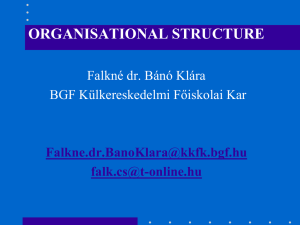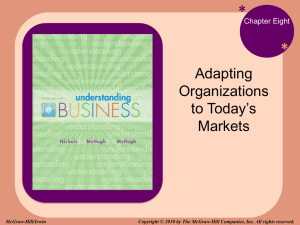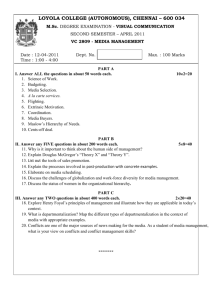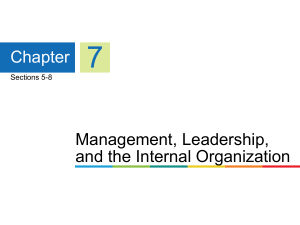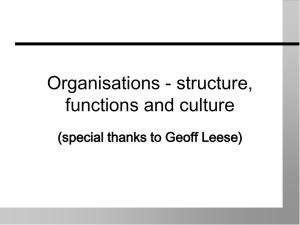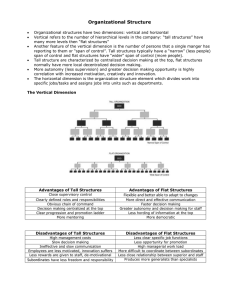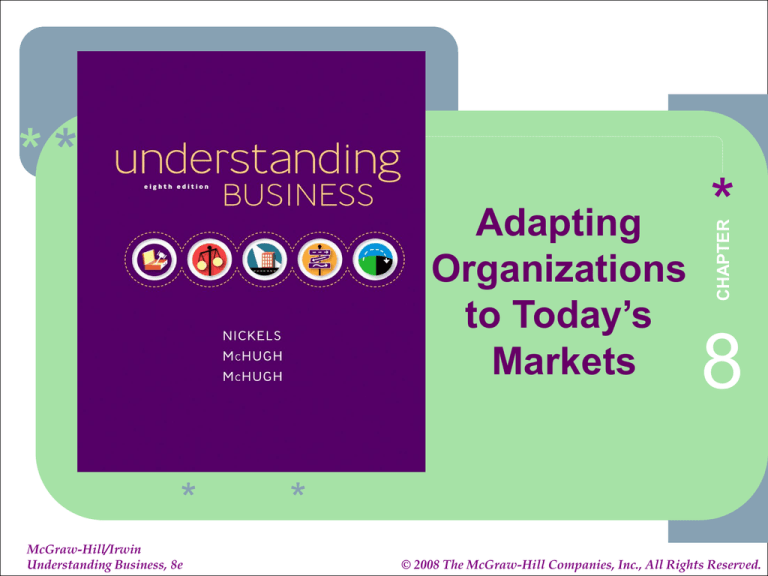
*
*
*
Adapting
Organizations
to Today’s
Markets
Nickels
*
8-1
McGraw-Hill/Irwin
Understanding Business, 8e
McHugh
*
CHAPTER
**
8
*
McHugh
1-1
© 2008 The McGraw-Hill Companies, Inc., All Rights Reserved.
*
* Building an Organization from the Bottom Up
*
Organizing or Structuring: Determine what work
needs to be done.
Departmentalization: The process of setting up
individual departments to do specialized tasks.
Assign Authority & Responsibility:
Division of Labor: Divide the tasks among others.
Job Specialization: Dividing the tasks into smaller jobs.
Organization Chart/Organogram
Allocating Resources:
Assigning Specific Tasks:
Establishing Procedures:
8-2
*
*
*
The Development of Organization Design
The shift from small business to large company
Mass Production: Method for efficiently producing
large quantities of goods.
8-3
Economies of Scale: The situation in which companies
can reduce theirs production costs if they can purchase
raw materials in bulk; the average cost of goods goes
down as production levels increase.
*
*
*
Fayol’s Principles of Organization
Unity of Command
Hierarchy of Authority
Division of Labor
Subordination of Individual Interests to the General
Interest
Authority
Degree of Centralization
Clear Communication Channels
Order
Equity
Esprit de Corps
8-4
*
*
*
Max Weber’s
Organizational Principles
8-5
Job Descriptions
Written Rules, Decision guidelines and
detailed records
Consistent Procedures, Regulations, Policies
Staffing/Promotions Based on Qualifications
*
* Turning Principles into Organization Design
*
Hierarchy: A system in which one person is at
the top of the organization and there is a ranked
or sequential ordering from the top down of
managers who are responsible to that person.
Chain of Command: The line of authority that
moves from the top of a hierarchy to the lowest
level.
Bureaucracy: An organization with many layers
of managers who set rules and regulations and
oversee all decisions.
8-6
*
* Decisions to Make in Structuring Organizations
* Centralized Authority: An organization structure
in which decision-making authority is maintained
at the top level of management.
Decentralized Authority: An organization
structure in which decision-making authority is
delegated to lower-level managers who are more
familiar with local conditions than headquarters
management could be.
Span of Control: The optimal number of
subordinates a manager supervises or should
supervise.
8-7
*
*
*
Centralization
(No Delegation)
Advantages
8-8
Greater Top-Management
Control
More Efficiency
Simpler Distribution
System
Stronger Brand/Corporate
Image
Disadvantages
Less Responsiveness
to Customers
Less Empowerment
Interorganizational
Conflict
Lower Morale Away
from Headquarters
*
*
*
Decentralization
(Delegate Authority)
Disadvantages
Advantages
Better Adaptation to
Customer Wants
More Empowerment of
Workers
Faster Decision
Making
Higher Morale
8-9
Less Efficiency
Complex Distribution
System
Less Top-Management
Control
Weakened Corporate
Image
*
*
*
Organization Structures
Tall organization: An organizational structure in
which the pyramidal organization chart would be
quite tall because of the various levels of
management.
Flat organization: An organization structure that has
few layers of management and a broad span of
control.
8-10
*
*
*
Organizational Structures
8-11
Tall Organizations
Many Layers of
Management
High Cost of
Management
Narrow Span of
Control
Flat Organizations
Current Trend
Creation of Teams
Broad Span of Control
*
*
*
Span of Control - Narrow
Disadvantages
Advantages
More Control by Top
Management
More Chances for
Advancement
Greater Specialization
Closer Supervision
8-12
Less Empowerment
Higher Costs
Delayed Decision
Making
Less Responsiveness to
Customers
*
*
*
Span of Control - Broad
Advantages
Reduced Costs
More Responsiveness
to Customers
Faster Decision
Making
More Empowerment
8-13
Disadvantages
Fewer Chances for
Advancement
Overworked Managers
Loss of Control
Less Management
Expertise
*
*
*
Departmentalization and its
advantage/disadvantage
Departmentalization: The dividing of organizational
functions into separate units.
8-14
*
*
*
Departmentalization
by Function
Advantages
Skill Development
Economies of Scale
Good Coordination
Disadvantages
• Lack of
Communication
• Employees Identify
with Department
• Slow Response to
External Demands
• Narrow Specialists
• Groupthink
8-15
*
*
*
Ways of Departmentalization
By Product
By Function
By Customer
Group
By Geographic
Location
By Process
8-16
*
*
*
Organizational Models
Line organization: An organization that has direct
two-way lines of responsibility, authority, and
communication running from the top to the bottom of
the organization, with all people reporting to only one
supervisor.
Line-and-staff organization: An organization that
has both line and staff personnel.
8-17
*
*
*
Organizational Models (cont…)
Line personnel: Employees who are part of the
chain of command that is responsible for achieving
organizational goals.
Staff personnel: Employees who advise and assist
line personnel in meeting their goals.
Matrix-style organization: An organization in which
specialists from different parts of the organization are
brought together to work on specific projects but still
remain part of a line-and-staff structure.
8-18
*
*
*
Line Organizations
Disadvantages
Advantages
Clear Authority &
Responsibility
Easy to
Understand
One Supervisor
Per Employee
8-19
Inflexible
Few Specialists for
Advice
Long Line of
Communication
Difficult to Handle
Complex Decisions
*
*
*
Line/Staff Organizations
Line Personnel
Staff Personnel
Formal Authority
Advise Line
Personnel
Make Policy
Decisions
Assist Line
Personnel
8-20
*
*
*
Matrix Organizations
Disadvantages
Advantages
Flexibility
Costly/Complex
Cooperation &
Teamwork
Confusion in Loyalty
Requires Good
Interpersonal Skills
& Cooperation
Not Permanent
Creativity
More Efficient Use of
Resources
8-21
*
*
*
Cross Functional Self-Managed Teams
Groups of employees from different departments
who work together on a long-term basis.
Self-managed means they are empowered to make
decisions without management approval.
Cross
functional team works better when it includes
customers, suppliers, and distributors too.
8-22
*
* Managing the Interactions among Firms
* Networking: Using communications technology and
other means to link organizations and allow them to
work together on common objectives.
Real Time: The present moment or the actual time in
which something takes place.
Virtual
Corporations:
A
temporary
networked
organization made up of replaceable firms that join and
leave as needed.
8-23
*
* Benchmarking and Core Competencies
* Benchmarking: Comparing an organization’s
practices, processes, and products against the
world’s best.
Core Competencies: Those functions that the
organization can do as well as or better than any
other organization in the world.
8-24
*
* Adapting to Change
* Digital Natives: Young people who have grown up
using the internet and social networking.
Restructuring: Redesigning an organization so that
it can more effectively and efficiently serve its
customers.
Inverted Organization: An organization that has
contact people at the top and the chief executive
officer at the bottom of the organization chart.
8-25
* Creating a Change-Oriented Organizational
* Culture
* Organizational (Corporate) Culture: Widely shared
values within an organization that provide unity and
cooperation to achieve common goals.
8-26
Myths, stories, traditions, values etc are part of corporate
culture
*
* Managing the Informal Organization
* Formal Organization: the structure that details
lines of responsibility, authority, and position; that is,
the structure shown on organization charts.
Informal Organization: The system that develops
spontaneously as employees meet and form cliques,
relationships, and lines of authority outside the
formal organization.
8-27



